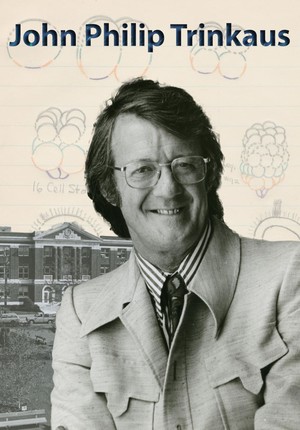Epiboly in Fundulus occurs when the enveloping layer of the blastoderm thins and spreads over the YSL and the yolk cell. As mentioned above in Chapter 6, "Genesis of a Research Problem", Warren Lewis had earlier proposed that epiboly occurs when the surface gel of the YCL contracts and exerts force on the blastoderm, initiating its movement. Trinkaus, in contrast, hypothesized that the YCL did not contract during epiboly; rather the YCL was engulfed by the YSL during epiboly, and the YSL could trigger the process of epiboly separately from the blastoderm (Kimmel & Weston 2003, 587; Trinkaus 1951). To support his hypothesis, Trinkaus surgically removed the blastoderm from the yolk cell – a procedure that requires considerable skill in microsurgery – and observed that the YSL continued to undergo epibolic movement without the blastoderm.
In subsequent work, Trinkaus discovered the structural features of the YSL, such as its actin-based cytoskeletal meshwork and its adhesive junctions, which enable it to perform its endocytic functions, engulfing the YCL, and to pull along the blastoderm during epiboly (Kimmel & Weston 2003, 587; Betchaku & Trinkaus 1986). These experiments allowed Trinkaus to make considerable progress in understanding the structure and function of the components of the early embryo. His early work on Fundulus epiboly established the importance of the YSL in the process of gastrulation, and it remains the accepted model of epiboly
Trinkaus also established that the blastoderm can move independently from the YSL during epiboly due to its deep cells that drive its locomotion. However, he didn’t think that the deep cell movements of the blastoderm were essential to the process of epiboly; they were merely an effect of the coordination of the deep cells forming the embryo (Trinkaus 1984).
Trinkaus’s work on Fundulus epiboly established the importance of the YSL in the process of gastrulation, and it remains the accepted model of epiboly in developmental biology. Trinkaus later studied the origins of the YSL, as well as the cellular mechanisms that could explain the locomotion of deep cells. He conducted most of this research during the summers in his lab in Whitman 210 at the MBL.
- Atz, James W. "Fundulus heteroclitus in the laboratory: a history." American zoologist 26, no. 1 (1986): 111-120.
- Betchaku, Teiichi, and J. P. Trinkaus. “Programmed endocytosis during epiboly of Fundulus heteroclitus.” American zoologist 26, no. 1 (1986): 193-199.
- Davis, Edward M., and J. P. Trinkaus. "Significance of cell-to-cell contacts for the directional movement of neural crest cells within a hydrated collagen lattice." Journal of embryology and experimental morphology 63, no. 1 (1981): 29-51.
- DuPont, Ellen M. "John Philip Trinkaus (1918-2003)." Embryo Project Encyclopedia (2012).
- Goodrich, H. B., and J. P. Trinkaus. "The differential effect of radiations on mendelian phenotypes of the goldfish, Carassius auratus." The Biological Bulletin 77, no. 2 (1939): 192-199.
- Goodrich, H. B., and J. P. Trinkaus. "The differential effect of radiations on mendelian phenotypes of the goldfish, Carassius auratus." The Biological Bulletin 77, no. 2 (1939): 192-199.
- Goodrich, H. B., N. D. Josephson, J. P. Trinkaus, and Jeanne M. Slate. "The cellular expression and genetics of two new genes in Lebistes reticulatus." Genetics 29, no. 6 (1944): 584-592.
- Keller, Ray, Wallis H. Clark, and Frederick Griffin (Eds.) Gastrulation: Movements, Patterns, and Molecules. New York: Plenum Press, 1991.
- Kimmel, Charles B., and James A. Weston. "An overview of Trink's scientific accomplishments." Developmental Dynamics 228, no. 4 (2003): 586-587.
- Saunders, John W. "Trink, the man." Developmental Dynamics 228, no. 4 (2003): 588-590
- Schoenwolf, Gary C. "Trink: His life, his philosophy." Developmental Dynamics 228, no. 4 (2003): 591-593.
- Tickle, Cheryll A., and J. P. Trinkaus. "Change in surface extensibility of Fundulus deep cells during early development." Journal of cell science 13, no. 3 (1973): 721-726.
- Tickle, Cheryll A, and J. P. Trinkaus. "Observations on nudging cells in culture." Nature 261, no. 5559 (1976): 413-413.
- Trinkaus, J. Philip. "Factors concerned in the response of melanoblasts to estrogen in the Brown Leghorn fowl." Journal of Experimental Zoology 109, no. 1 (1948): 135-169.
- Trinkaus, John Philip. "The surface gel layer of Fundulus eggs in relation to epiboly." Proceedings of the National Academy of Sciences of the United States of America 35, no. 4 (1949): 218.
- Trinkaus, John Philip. "A study of the mechanism of epiboly in the egg of Fundulus heteroclitus." Journal of Experimental Zoology 118, no. 2 (1951): 269-319.
- Trinkaus, John Philip. "The differentiation of tissue cells." American Naturalist (1956): 273-289.
- Trinkaus, John Philip. “Procurement, maintenance and use of Fundulus eggs,” Methods in Developmental Biology. F.H. Wells and N.K. Wessells (Eds.) Crowell, New York: 1967, 113-122.
- Trinkaus, J. P. "The cellular basis of Fundulus epiboly. Adhesivity of blastula and gastrula cells in culture." Developmental biology 7 (1963): 513-532.
- Trinkaus, J. P. "Surface activity and locomotion of Fundulus deep cells during blastula and gastrula stages." Developmental biology 30, no. 1 (1973): 68-103.
- Trinkaus, J. P. "Mechanism of Fundulus epiboly—a current view." America n Zoologist 24, no. 3 (1984): 673-688.
- Trinkaus, John Philip. Cells into organs: the forces that shape the embryo. (2nd Ed.) New Jersey: Prentice-Hall, Inc., 1984.
- Trinkaus, John Philip. “Directional cell movement during early development of the teleost Blennius Pholis. I. Formation of epithelial cell clusters and their pattern and mechanism of movement.” Journal of Experimental Zoology 245 (1988a): 157-186.
- Trinkaus, John Philip. “Directional cell movement during early development of the teleost Blennius Pholis. II. Transformation of the cells of epithelial clusters into dendritic melanocytes, their dissociation from each other, and their migration to and invasion of the pectoral fin buds.” Journal of Experimental Zoology 248 (1988b): 55-72.
- Trinkaus, John Philip. Embryologist: My Eight Decades in Developmental Biology. J&S Publishing Company, 2003

